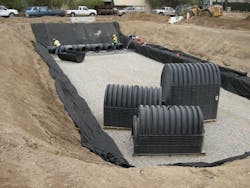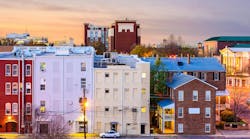Storage & Infiltration: Going for Gold
The Foothill Gold Line (also known as the Gold Line Foothill Extension) is a 24-mile extension of the Los Angeles County Metropolitan Transportation Authority (Metro) Gold Line light-rail corridor that will run east from the Gold Line’s current terminus in Pasadena, Calif., through the “Foothill Cities” of Los Angeles County into San Bernardino County. The extension will go a long way to address the dire traffic challenges that keep Southern Californians stuck on freeways for hours each day.
The plan currently is being implemented as two separate mass transit projects, known as Phase 2A (Pasadena to Azusa) and Phase 2B (Azusa to Montclair). Phase 2A is near completion, while Phase 2B is in the final engineering stage. The two segments are estimated to have a combined cost of almost $2 billion. A total of $810 million has been allocated to the project between 2010 and 2019. A majority of this money is being used to design, build and purchase equipment to operate the Foothill Gold Line from Pasadena to Azusa and complete planning for the segment from Azusa to Montclair.
Construction of Phase 2A began in June 2010. This extension will run more than 11 miles from the current Sierra Madre Villa Station in East Pasadena to Azusa. Construction also includes six new stations and the new Gold Line Bridge, a $18.6 million, 584-ln-ft bridge stretching diagonally across the eastbound I-210 freeway in the city of Arcadia.
The expansion also necessitated a new Maintenance and Operations (M&O) Campus, which was built on 24 acres in the city of Monrovia. The M&O facility will be used for servicing, cleaning, painting and storing light-rail vehicles for Metro’s growing fleet. The facility will have the capacity to house and maintain up to 84 light-rail vehicles and 200 staff members.
The M&O will be one of the largest facilities in the entire Metro system and the only facility thus far that meets the U.S. Green Building Council’s LEED Gold standards. The train yard complex includes more than 700 solar panels that will generate approximately 22,000 kWh per month of electricity, a train car wash that uses only recycled water and other sustainable features.
Storm Water Features
Engineers from Parsons Corp. designed a comprehensive storm water management system that contributed to the sustainability of the site and LEED certification standards. Storm water runoff from roofs, parking lots and other impervious surfaces will be captured, treated and infiltrated for groundwater recharge. The site also will treat storm water runoff from a neighboring 3M manufacturing site.
In the Los Angeles area, infiltration is a preferred low impact development design strategy, helping to meet storm water quality requirements by reducing runoff while providing groundwater recharge benefits. The design storm for this project is a 0.75-in., 24-hour storm event (112,000 gal).
Corrugated metal pipe, often utilized for underground infiltration, could not be used for this project due to concerns about conductivity from the many rail lines within the site. The Parsons design team instead selected Contech’s ChamberMaxx, a corrugated, open-bottom plastic infiltration chamber system that allows the treated water to be detained and infiltrated into the groundwater aquifer below.
Parsons worked with Contech engineers to design a system using three underground infiltration systems, two of which were constructed from the ChamberMaxx infiltration chambers.
Each system utilized 54 chambers to provide an infiltration volume of 5,000 cu ft per system, but they were arranged in different layouts to accommodate specific site restraints. One system was long and narrow (15.7 ft by 135.6 ft) and was situated at the back of the facility, and the other was wider and shorter (29.8 ft by 71.5 ft), placed under a rear parking area.
All three infiltration systems were pretreated using CDS hydrodynamic separators. CDS uses swirl concentration and continuous deflective separation to screen, separate and trap trash, debris, sediment and hydrocarbons from storm water runoff. Pretreating with CDS can prolong the life of the infiltration systems by removing the debris and sediment that can collect within the stone backfill voids. Pretreatment with CDS also aids in maintenance, as the units are easier to clean and maintain compared with the infiltration system itself.
Dedication & Reception
A community open house and dedication for the new facility took place in May 2015. Elected officials at all levels of government, transportation officials and hundreds of community stakeholders attended the event. The open house included exhibits of the technology used within the new facility, including an exhibit of the technology used in the storm water management system, which generated attendee interest and helped show how taxpayer dollars were being used to treat and recharge storm water.
The Foothill Gold Line from Pasadena to Azusa was completed on time and on budget in September. The project has been turned over to Metro for pre-revenue service, with passenger service beginning in March 2016.
Download: Here


